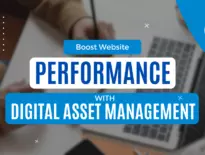Businesses today have huge collections of digital assets. As they grow over time, keeping them organized can be increasingly challenging. Organizing them efficiently from as early as possible allows for easier scalability.
Cincopa is a digital asset management platform that gives businesses easy ways to organize and tag their digital assets. They can manage them in such a way that they get the best use out of them.

Understanding the significance of organizing digital assets
Organizing digital assets has many benefits for businesses such as improving efficiency, productivity, collaboration, and discoverability.
- Streamline asset retrieval and accessibility: Digital assets include images, documents, videos, and other files. Without proper organization, it is difficult to find specific assets. Searching for them can be frustrating and time-wasting. With a structured organizational system, it is easier and quicker to retrieve digital assets. Accessibility to data is essential for efficient workflows.
- Improve collaboration and productivity: Whether employees are working on a project together or simply managing their own files, an organized digital asset system makes them more productive. Structuring assets in a logical way enables seamless collaboration as everyone can easily find and use the right files. Employees have a single source of truth for sorting, storing, sharing, and securing digital assets. They can use a huge variety of assets to conduct business operations for everything from marketing to recruiting.
- Enhance searchability and discoverability: Categorizing and tagging digital assets with relevant metadata creates a searchable database. This enables employees to find specific information even when a collection of digital assets is very large.
Introducing Cincopa’s Digital Asset Management Solution
Cincopa is an enterprise digital asset management system. It provides a centralized platform that can help to improve efficiency and make it easy for teams to adhere to a consistent brand strategy. They are able to easily serve the right version of a video to the right person at the right time no matter their screen size, bandwidth, or platform. The interface is intuitive and it has user-friendly functionalities that help with efficient asset management.
Seamless integration with existing software solutions enables businesses to use videos for many different purposes. Teams don’t have to constantly switch apps or upload and download files.
One easy-to-use dashboard: In Cincopa users can view, edit, organize, and analyze all media assets from one dashboard. They can access and manage an account from any device connected to a Cincopa account.
Metadata and tagging digital assets: A tag is a keyword or term assigned to an asset, such as a video, image, or gallery. This helps to group, manage, filter, or search for items.
Adding tags to multimedia assets and to galleries increases the probability of having assets discovered in on-site searches. When everyone uses a standard process for metadata and tagging digital assets, all valuable information is readily accessible.
Most assets undergo many changes between the first version and the final version. Metadata can help to ensure versions are associated with each other and yet easy to identify in their own right.
Consistent naming conventions: Using consistent naming conventions makes it easier to look for digital assets. This helps to ensure all files are uploaded with the same name structure.
Including a specific type of metadata, a campaign name, keywords, and tags makes the whole process of searching for digital assets much easier.
Built-in SEO: Filling in the caption and description for every media asset in a gallery improves search rankings. SEO features are automatically included in embed code in Cincopa so when a gallery is added to a web page it is properly indexed.
In-video search: Viewers can search inside videos for any word or term and go straight to where it is mentioned. Adding chapters to videos allows viewers to go to a specific chapter. They can watch specific parts of a video instead of having to watch it all.
Account switching: Users who have access to multiple accounts on Cincopa can easily switch accounts. They can access a video on a different account if necessary with a few clicks.
Security: Encryption protocols, backups, 2FA authentication, Single sign-on (SSO), watermarks and Domain Lock are some of the security features Cincopa uses to secure digital assets.
User permissions and access options: Collaboration and user permissions go together. User permissions help to ensure that people only have access to the information they need. Tiered security access options allow businesses to distinguish between different types of content and roles.
Advanced analytics: Businesses can get quick stats for all galleries and assets from the Cincopa dashboard. Advanced analytics such as heatmaps allow businesses to see when and who is utilizing digital assets and for what purpose. Engagement metrics like this can help with identifying which digital assets work best and improving those that don’t work as well.

Defining a structured organizational system
The first step in defining a structured organization system is to prioritize the most useful assets. For example, if a department constantly uses the same type of content, a custom portal can give them access to pre-approved assets and save time.
Categories: Businesses need to decide on the most logical way to categorize their digital assets. Cincopa allows users to categorize digital assets in various ways. For example, users can create multimedia albums with files grouped using tags. Video galleries have categories and playlists. Advanced video portals allow different departments to keep their digital assets organized in a way that suits them best.
Sufficient storage space: Digital assets usually include large files in various formats which take up plenty of space. Businesses must have sufficient storage space for their digital assets. This helps to eliminate redundancies, save server space, and prevent losing track of data. With Cincopa businesses can utilize different approaches to storage for varying needs. This means they don’t have to worry about storage and can locate digital assets in the most appropriate places for optimal use.
Automate workflows: Automating workflows such as tagging and file format conversion helps to save time and money.

Regular maintenance and asset cleanup
Asset cleanup and maintenance can help to keep an asset library organized. It is important to regularly review digital assets. Forgotten files and outdated assets can quickly accumulate. Reporting tools can help businesses to find inactive users, assets that aren’t being downloaded, and empty metadata fields. User surveys can also help with gathering this information. Businesses can use the following tips to decide which digital assets to archive.
- They haven’t been shared in over a year.
- They do not live up to current quality standards.
- They include terminated personnel.
- They are duplicates or triplicates of content.
It is also important to review security settings and ensure that everyone still has the correct level of access. Are there unused users or asset groups? Reviewing search analytics ensures that terms used for search are being implemented in metadata structure.
Conclusion
Best practices for digital asset management include auditing assets, leveraging analytics, and taking advantage of roles and permissions. Automating tasks such as image conversion or distributing content across various channels can save time and money. Developing clear, consistent protocols for categorizing digital assets and creating metadata maximizes search capabilities. Cincopa is a digital media management platform that offers all of these capabilities and more.










